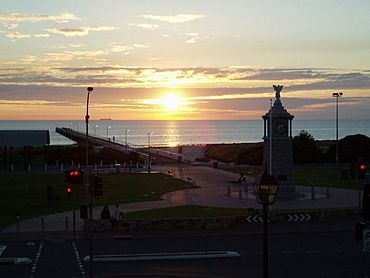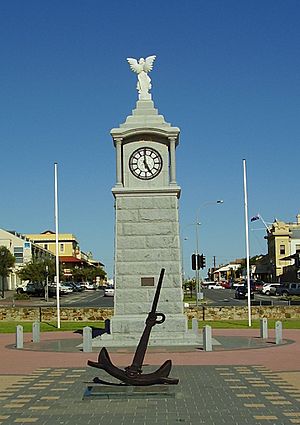Semaphore, South Australia facts for kids
Quick facts for kids SemaphoreAdelaide, South Australia |
|||||||||||||||
|---|---|---|---|---|---|---|---|---|---|---|---|---|---|---|---|

Semaphore beachfront and jetty
|
|||||||||||||||
| Established | 1849 | ||||||||||||||
| Postcode(s) | 5019 | ||||||||||||||
| Location | 14 km (9 mi) from CBD | ||||||||||||||
| LGA(s) | City of Port Adelaide Enfield | ||||||||||||||
| State electorate(s) | Port Adelaide | ||||||||||||||
| Federal Division(s) | Hindmarsh | ||||||||||||||
|
|||||||||||||||
| Footnotes | Coordinates Adjoining suburbs |
||||||||||||||
Semaphore is a cool suburb in Adelaide, South Australia. It's on the coast, right by the Gulf St Vincent. This area is part of the Lefevre Peninsula, about 14 kilometers from the center of Adelaide.
Contents
Discovering Semaphore's Past
Semaphore was first mapped out for people to buy land in 1849. Back then, it was quite cut off. There were swamps to the south and the Port River to the east.
How Semaphore Got Its Name
In 1851, a famous actor and hotel owner named George Coppin built a hotel here. He put up a really tall flagpole. This pole was used to send signals to his other hotel in Port Adelaide. It would tell them when ships were coming! This signaling gave the area its unique name: Semaphore.
Early Communication and Timekeeping
An official government signal station opened in 1856. Here, officers would keep track of all the ships in Gulf St Vincent. They also recorded things like water depth and tides. A Telegraph Office opened in 1856, which later became a Post and Telegraph Office in 1871.
In 1875, the Time Ball Tower was built next to the Signal Station. This tower would drop a ball at a specific time each day. This helped ships set their clocks correctly.
Connecting to Port Adelaide
Semaphore was separated from Port Adelaide by the Port River. But in 1859, a wooden bridge was built, making travel much easier. This bridge was later replaced by the Jervois Bridge. The very next year, in 1860, the Semaphore jetty was built.
In 1880, a strong, round brick tower was built on Blackler Street. Its walls were 2 meters thick! This tower helped keep water flowing when the Jervois Bridge had to be lifted for ships. It was used until 1972 and is now a home.
Local Government and Growth
The Corporate Town of Semaphore was officially created in 1884. This brought all the local government for Semaphore into one place. Before this, it was split between two other councils. Today, Semaphore is part of the City of Port Adelaide Enfield.
In 1884, the Mechanics Institute was built. This building became the Semaphore Town Hall in 1889. Today, it is the historic Semaphore Library.
The new road to Port Adelaide made it easier for people to live in Semaphore and work in the city. More homes, churches, schools, and pubs were built. A railway was added in 1878, bringing wealthy holidaymakers to the seaside. Fun carnivals, shows, and outdoor cinemas opened up. In 1917, a tram service from Port Adelaide also started.
The Odeon Star Cinema's Story
From 1911 to 1919, an outdoor cinema showed silent films on the Esplanade during summer. Later, the company built the Wondergraph Picture Theatre, which opened in May 1920.
In 1928, a huge merry-go-round was built. It was the largest in Australia and used an electric motor, which was very modern for its time.
Tough Times in the 1930s
The Great Depression in the mid-1930s was a difficult time for Semaphore. The tram service closed down. The Signal Station and Time Ball Tower moved their work to Outer Harbor. The jetty also became shorter due to storm damage, and repairs were too expensive.
What Semaphore Is Like Today
Semaphore is a mostly residential suburb. It is bordered by Union and Hargrave Streets to the north and Hart Street to the south. To the west is the beautiful Gulf St Vincent. Woolnough Road and Swan Terrace are to the east.
Because it's by the sea, Semaphore is a popular spot for visitors. You can find many restaurants, takeaway food places, and other shops for tourists. It's right next to Semaphore South, Glanville, Exeter, and Largs Bay.
Famous Landmarks in Semaphore
The Semaphore jetty was finished in 1860. It used to be 652 meters long, but today it's 585 meters. From the jetty, you can see the Fort Glanville steam train. This train is a heritage item run by the National Railway Museum. A World War I memorial clock was built in 1925 at the start of the jetty.
The house where Sir Ross Smith was born is still standing. He was a famous aviator who flew from the United Kingdom all the way to Australia! You can find his birthplace at 36 Newman Street.
The Odeon Star Cinema
The Odeon Star on Semaphore Road is the oldest cinema in Adelaide built just for movies. It opened on May 22, 1920, as the Wondergraph Picture Palace. A famous architect named Eric McMichael designed it.
It was renamed Star Theatre in 1930. In January 1931, new sound equipment was added so it could show "talkies" (movies with sound!).
After some changes in ownership, it became the Semaphore Odeon Cinema in 1952. It closed in 1976 because fewer people were going to the movies. The building then became a furniture shop.
But it was renovated and reopened as the Odeon Star on December 19, 1991. It was made bigger and updated in 1997, becoming a three-screen cinema. Today, it's run by independent operators and still shows movies.
Fun Things to Do and Places to Visit
Semaphore's beach is the busiest on the LeFevre Peninsula. It's the easiest beach for people living in Adelaide's northern suburbs to get to. There are big car parks near the beach for visitors. During summer weekends, the Semaphore Surf Life Saving club patrols the beach to keep swimmers safe.
The beach is wide with lots of sand. The waves are usually small, which is great for swimming. However, it's not usually good for surfing. There are sandbars that go out quite a distance. Be careful of holes or channels in the sand, as they can be a safety concern. Also, never jump from the jetty, as the water depth changes a lot.
The jetty is a central spot for fun events. These include the yearly Kite Festival and the Greek Festival.
Schools and Learning
The local public primary school is LeFevre Primary School. It's in the nearby suburb of Birkenhead. The local high school is LeFevre High School, located in Semaphore South.
The only school actually in Semaphore is Dominican Primary School. This is a private school run by the Catholic Education Office. Another nearby private school is Portside Christian College in Ethelton, which has both primary and secondary students.
Semaphore has the historic Semaphore Library. Semaphore Road also has many shops. Some shops are for the many summer visitors, offering food, clothes, and gifts. Semaphore Road was even voted the best main street in South Australia in 2014!
The Odeon Star cinema regularly shows films. It also has special screenings for the Adelaide Film Festival.
Historic Places in Semaphore
Semaphore has many places that are important to its history. These are called heritage-listed sites:
- 40 Blackler Street: Semaphore Water Tower
- Semaphore Road: Semaphore Soldiers Memorial Clock
- Esplanade: Semaphore Palais
- 64 Esplanade: A historic house
- 68 Esplanade: Richard Jagoe's House
- 74 Esplanade: Semaphore Customs Boarding Station
- 176-186 Military Road: Bute Terrace
- 6 Newman Street: A historic house
- Semaphore Road: Semaphore Jetty
- Semaphore Road: Semaphore Timeball Tower
- 10-14 Semaphore Road: Semaphore Soldiers Memorial Hall, designed by Christopher Arthur Smith.
- 10-14 Semaphore Road: Semaphore Library
- 15 Semaphore Road: Semaphore Post and Telegraph Office
- 43 Semaphore Road: Warrinilla
Getting Around Semaphore
You can catch the 157 and 333 buses on Military Road. The 352 and 353 buses stop on Semaphore Road.
The Glanville railway station is close by. Trains run to the Adelaide city center every 30 minutes every day.
Most main roads have special lanes for bikes, but these are often only for busy times. There's also a separate path for cycling and walking along the beach. Another separate path forms a loop through Semaphore, Ethelton, Port Adelaide, and New Port.
You can find some short-term car parking along Semaphore Road. Larger car parks for longer stays are along the foreshore, accessed from The Esplanade. Many residential streets also have parking for visitors. In older parts of Semaphore, many houses were built before cars were common, so residents often park on the street.
Famous People From Semaphore
- Susan Close – a politician
- Frank Hatherley – a broadcaster
- Colin Hayes – a horse trainer
- Geoffrey Proud – an artist
- Charles Todd – a pioneer in telegraphs and weather forecasting
Images for kids





